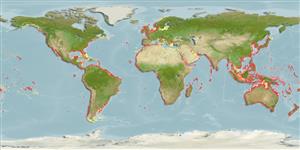Florideophyceae |
Gelidiales |
Gelidiaceae
Environment: milieu / climate zone / depth range / distribution range
Ecology
Sessile; depth range 0 - 37 m (Ref. 102166). Subtropical
Atlantic, Mediterranean and Indo-Pacific oceans: from USA to Uruguay including Gulf of Mexico and the Caribbean, east to Norway and south to Namibia including the Mediterranean; from the Arabian Sea, including Persian Gulf, Oman Sea and the Red Sea, south to Tanzania including Seychelles, east to India and south to Western Australia, including Andaman Sea; from Japan to the South China Sea, south to New Zealand, Hawaii and Chile.
Length at first maturity / Size / Weight / Age
Maturity: Lm ? range ? - ? cm Max length : 1.0 cm H male/unsexed; (Ref. 80701)
Turf formation in the upper intertidal, blackish-red colour when slightly dry, and extensive rhizoids (Ref. 80701). On rock in upper intertidal forming extensive mat-like growths below Pelvetia canaliculata, particularly on vertical or near-vertical surfaces. Sometimes associated with Catenella caespitosa and Rhodothamniella purpurea. Widely distributed, common (Ref. 80701). Also on volcanic rocks at shallow intertidal to subtidal depths (Ref. 80999).
Life cycle and mating behavior
Maturity | Reproduction | Spawning | Eggs | Fecundity | Larvae
Guiry, M.D. and G.M. Guiry 2009 AlgaeBase. World-wide electronic publication, National University of Ireland, Galway. http://www.algaebase.org; searched on 14 April 2009. (Ref. 80701)
IUCN Red List Status
(Ref. 130435: Version 2025-1)
CITES status (Ref. 108899)
Not Evaluated
Not Evaluated
Threat to humans
Human uses
| FishSource |
Tools
More information
Trophic EcologyFood items (preys)
Diet composition
Food consumption
Predators
Population dynamicsGrowth
Max. ages / sizes
Length-weight rel.
Length-length rel.
Length-frequencies
Mass conversion
Abundance
Life cycleReproduction
Maturity
Fecundity
Spawning
Eggs
Egg development
Larvae
PhysiologyOxygen consumption
Human RelatedStamps, coins, misc.
Internet sources
Estimates based on models
Preferred temperature
(Ref.
115969): 10.7 - 29.1, mean 26.9 (based on 7544 cells).
Fishing Vulnerability
Low vulnerability (10 of 100).
